Optimizing Space Applications with Reed Relay Technology
Putting electronic systems into space – be it into a low Earth orbit, our solar system or beyond– is an expensive business. For example, the cost of putting anything into space is estimated to be between $2,000 and $3,000 per kilogram. Understandably, the systems must operate as intended and provide several years of service to justify such high costs. All components used within the system must therefore be reliable and fit-for-purpose.
In this application guide, we will explore these harsh environments and discuss the characteristics of reed relays that make them ideal for an array of different switching applications; and the benefits of reed relays over electromagnetic relays (EMRs) and solid-state relays (SSRs) for space applications.

Whether an application is intended for use in orbit or on another planet, temperature is a key consideration as it can vary between extreme lows and extreme highs. Most EMRs and SSRs have an operating temperature range of -40°C to +85°C. Above +85°C, both will suffer from degraded performance, especially the SSR which may be permanently damaged. All relays (reed and EMRs) experience coil resistances change due to temperature fluctuations, which in turn changes the operate voltage. Pickering can offer reed relays with an extended operating temperature range of -40°C to +150°C, over which there will be minimal change in performance.
The below graph compares the operate voltage of a standard 5V relay compared to a Pickering high temperature Series 104. With a 5 Volt coil drive, the standard relays would have unstable operation beyond +85°C and would not operate beyond +100°C. However, the Pickering high temperature 104 maintains the correct overdrive all the way to +150°C, ensuring stable performance.
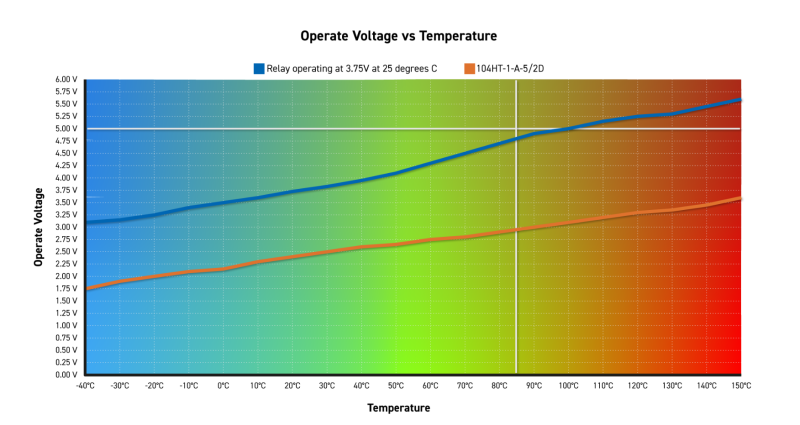
Finding this guide interesting?
Download the full guide now to learn more about utilizing reed relays in space applications.
Contents of the application guide:
- Switching in Extreme Environments
- Low Level & Low Power Switching
- Switching Terminology
- Recommended Switching Technology
- Recommended Reed Relays

Recommended Reed Relays for use in Space Applications
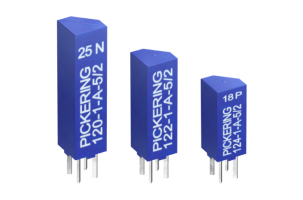
Ultra High Density Reed Relays
These relays have a maximum switch current of 1A (up to 20W), and the maximum carry current is 1.2A. Fast operate and release times (as low as 80μs or less) make these relays suitable for high-speed test systems. Body dimensions from (W x H x D): 3.9 x 9.5 x 3.9mm. Available forms: 1 Form A contact configuration.

High Density Reed Relays
These relays have a maximum switch current of 1A (up to 20W), and the maximum carry current is 1.2A. Switches feature sputtered ruthenium contacts for long life and high reliability. Body dimensions from (W x H x D): 6.6 x 9.5 x 3.7mm. Available forms: 1 Form A, 1 Form A Coax, 2 Form A, 1 Form B, and 1 Form C contact configurations.
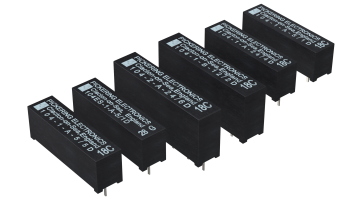
Miniature High-Voltage Reed Relays
These relays have switching voltages up to 1.5kV and standoff voltages up to 5kV. The maximum switch current is 1A (up to 25W) and the maximum carry current is 1.5A. High coil resistance options (up to 6.8kΩ). Thermal EMF devices are between 3 and 10μV. Relays can endure temperatures as high as 150°C if requested. Body dimensions from (W x H x D): 12.5 x 6.6 x 3.7mm. Available forms: 1 Form A, 2 Form A, and 1 Form B contact configurations.
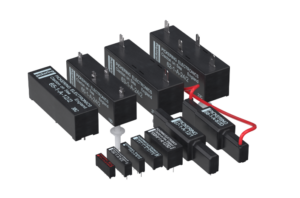
High Voltage Reed Relays
These relays have switching voltages up to 12.5kV and minimum standoff voltages up to 20kV. The maximum switch current is 3A (up to 200W) and the maximum carry current is up to 5A. Option of PCB pins, chassis, PCB mounting, and flying leads. Body dimensions from (W x H x D): 58.4 x 19.0 x 12.6mm. Available forms: 1 Form A, 1 Form B, and 1 Form C contact configurations.
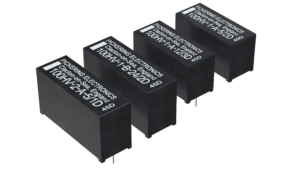
High Coil Resistance Reed Relays
These relays have a maximum switch current of 1A (up to 20W), and the maximum carry current is 1.2A. Featuring high coil resistances (up to 6kΩ), devices are ideal for portable instruments. Body dimensions from (W x H x D): 8.13 x 15.24 x 4.8mm. Available forms: 1 Form A, 2 Form A, 1 Form B, and 1 Form C contact configurations.
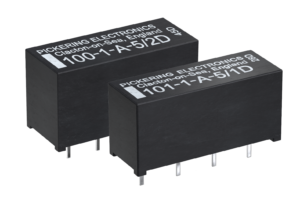
Low Thermal EMF Reed Relays
These relays have a maximum switch current of 1A (up to 20W), and the maximum carry current is 1.2A. Devices feature low thermal EMF (around 1μV or less) and low power consumption. Body dimensions from (W x H x D): 20.1 x 9.4 x 7.4mm. Available forms: 1 Form A, 2 Form A, 1 Form B, and 1 Form C contact configurations.
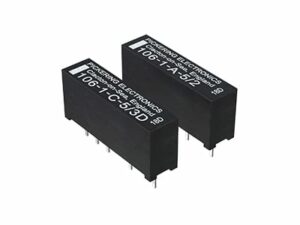
Industry Standard Size Reed Relays
These relays have a maximum switch current of 1A (up to 20W), and the maximum carry current is 1.2A. Featuring superb contact resistance stability and ultra-high insulation resistance. Body dimensions from (W x H x D): 19.1 x 7.6 x 4.8mm. Available forms: 1 Form A, 2 Form A, 1 Form B, 1 Form C, and 2 Form C contact configurations.
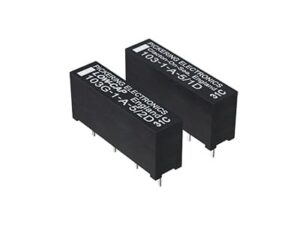
Low Capacitance Reed Relays
These relays have a maximum switch current of 1A (up to 20W), and the maximum carry current is 1.2A. Ultra-low capacitance levels of typically 0.1pf, compared to typically 2.5pF for a standard device. Body dimensions from (W x H x D): 19.1 x 8.1 x 4.8mm. Available forms: 1 Form A contact configuration.
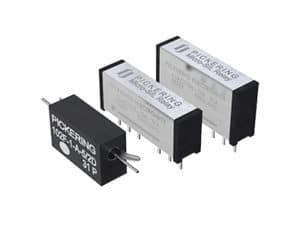
Coaxial Reed Relays
These relays have a maximum switch current of 1A (up to 20W), and the maximum carry current is 1.2A. Devices with 50 and 75Ω coils are suitable for up to 5GHz, making them ideal for RF Signal Switching, RF switched tunable filters, and High-Speed Digital Switching. Available in thru-hole and SMT. Body dimensions from (W x H x D): 12.5 x 6.6 x 3.7mm. Available forms: 1 Form A and 1 Form B






